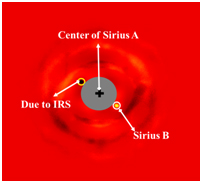In December 2013, the visitor instrument program submitted to ESOhas been awarded with 6 observational nights of New Technology Telescope (NTT) at La Silla Observatory in Chile, which is proposed by the exoplanets detecting research group at NIAOT. The title of this program is “High-contrast imaging observation of giant exoplanets and Brown Dwarfs on NTT”. In this program, we proposed to develop a high-contrast imaging system as a visitor instrument on NTT, whichwill be used forthe direct imaging research of young exoplanets(EPs) or brown dwarfs (BDs) in both J and H band.The high-contrast imaging system is composed of an Extreme Adaptive Optics (Ex-AO),a step-transmission-filter based coronagraph as well as the image rotation and subtraction (IRS) data reduction system.
The target goal of this instrument should finally deliver a contrast of 10E-6 at an inner working angular (IWA) distance of 4λ/D (0.35" at H band), which is 10 times better than current on-going Exoplanets imaging projects. This program is awarded in the collaboration between NIAOT (Exoplanets Imaging Research group) and AIUC at PUC (Prof. Leopoldo Infante’s group).A brief information of the awarded program (Awards No: 093.C-0326) can be found through the website as follows:
http://archive.eso.org/wdb/wdb/eso/approved_runs/form
The direct imaging of EP is one of the most important researches in astronomy; however, it is a very challenge work. Currently, only few groups in the world can do exoplanets imaging mostly based on 8-10 meter class telescopes, such as VLT/NaCo, Gemini/NIRI, Keck II/NIRC2 (see papers by Marois et al. 2008, 2010). In Serabyn’s 2010 work, it has demonstrated the possibility to image exoplanets on small telescopes (using a quarter of Hale telescope Primary at Palomar observatory, see Serabyn et al. Nature 2010).
In October 2013,our Ex-AO system has demonstrated a contrast of 10E-4by the direct imaging observation of Sirius A/B with the 1.6-meter McMP solartelescope located at Kit Peak NOAO. Sirius A/B is a binary system, where Sirius B is a white dwarf and has a contrast of ~10E-4 to its primary at the working wavelength of H band (see Figure 1).
However, as an initial observation of high-contrast imaging for demonstration purpose, we have fully demonstrated the feasibility and ability to carry out the direct imaging observation of exoplanets with our high-contrast instrument. For instance, exoplanet of HR 8799 b has a contrast of 10E-4 to its primary.
The above observation is performed by the Research Group for Exoplanet High-Contrast Imaging and Ex-AO, jointed by Nanjing Institute of Astronomical Optics & Technology (China) and California State University Northridge (USA), which is supported by NSFC undergrant № of 11220101001.

Fig. 1.IRS reduced Sirius Image taken with our Ex-AO system.
In the next step, we will develop the high-contrast imaging instrument for NTT, which is composed of Ex-AO, Coronagraph and IRS data reduction system, respectively. The observational will be carried out on July 16-20, 2014. Meanwhile, we will apply the observational time of 3.5 meter telescope in Apache Point Observatory, USA. And a 16-bit scientific grade NIR camera will be finally usedin the observation(read-out noise<15 e- with liquid nitrogen cooling). OurEx-AO will be updated with a 97 or 277-actuator DM, which can provide a precise wave-front correction of ~100 orders (of Zernike polynomial) at a 2 KHz frequency. An apodized transmission filter will be integrated into the AO system for coronagraph imaging, which is optimized for NTT input pupil.Currently, we have finished the design of the high-contrast coronagraphic system, in which the target contrast is 10E-6 at 4λ/D.
According to our knowledge, it will be the first time for the Chinese Astronomical Society to carry out the near infrared wavelength research with our own developed visitor instrument, including both technique of high-contrast imaging instrument development and scientific observation of EP/BD.